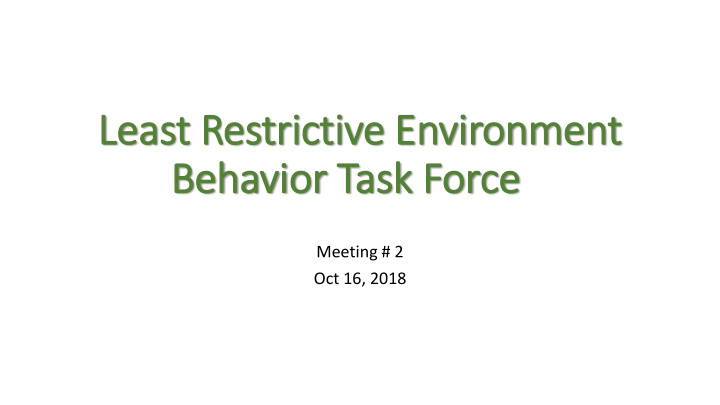



Least Restrictive Environment Behavior Task Force Meeting # 2 Oct 16, 2018
Review — Meeting #1 Work Welcome! THANKS FOR SERVING ON THIS IMPORTANT TASK FORCE! (Introduction — Members new this meeting)
Task Force Makeup and Introductions 50 Members — Voting and Resource Members • Service Providers • Administrators • Parents • Teachers • Legislators • Community Members • Advocates This Photo by Unknown Author is licensed under CC BY-NC-SA
Review — Meeting #1 Work • Sept 27, 2018
Meetings • Five meetings • Two hours each, 3:30-5:30 • Sept 27 • Oct 16 • Oct 30 • Nov 8 • Nov 30 • Report on/soon after Nov 30 • Jon L. Wanzek Center for Scouting
• Introductions – Voting Members; Resource Members • Share goals/charge of the task force. • Share/reach consensus on group norms (use response software to gauge consensus) • Share overview of the group’s work, how it will proceed/processes to be utilized. • What are the needs that bring us together? Discussion: How are children with the most intense behavior needs served in ND and in our community? Meeting #1: Sept 27
Discussion of Sugg ggested Norms for Task Force • Begin on time and end on time. • Stay on agenda. • Avoid side conversations. • Respect questions. • Listen respectfully. • Probe ideas; do not criticize people. • Monitor your own airtime. • Monitor use of technology • Other? (Discussion/sharing)
• 80% Consensus of the committee members present at the time of the “vote”. Discussion--Consensus • 80% Consensus, this means that all participants support the decision except for up to 20%. The dissenters can't block the decision, but should be given the opportunity to share their concerns. • 80% Consensus of the committee members present at the time of the “vote.” • Response software or “fist -to- five” will be used to gauge consensus.
Enter Question Text A. True B. False
Discussion/Clarification: TASK FORCE “CHARGE” • Determine how children are currently Study and make advisory recommendations regarding being served and whether it is programming, services, adequate. configuration/locations and costs to • Determine types of services/supports serve and support children with strong and curriculum needed to support behavioral needs in our students with behavioral needs. community/region. • Reach consensus on critical attributes of desired programming and services. • Reach consensus on most feasible configuration for our community/region, including cost and location considerations. • Provide a report on the task force’s work and advisory recommendations to boards.
The committee’s charge is clear and one I can collaborate to achieve. A. Strongly Agree B. Agree C. Disagree D. Strongly Disagree
Overview>Committee Process Solutions: Advisory Solutions: Task Force Recommendat- Configurations> Formation: ions Brainstorm> Pros/Cons Critical Introductions> Description Evaluate Attributes> Purpose;> with Pros/Cons: Congruence (Consensus)> Problem Top 2-3 with Critical Evaluate/Rank Identification;> potential Attributes Critical models Norms> Process >Consensus Attributes Final Report
0 1 2 3 4 5 Degree of Congruence 5 4 3 2 1 0 Proposed Delivery Critical Desired Attributes Location/Model
The processes outlined for the committee’s tasks are workable. A. Strongly Agree B. Agree C. Disagree D. Strongly Disagree
Serving Children With Behavior Needs — Current Continuum of Services • Presentation/Discussion John Porter
Agenda — Meeting #2 — 10/16/18 1. Presentation- sample Preview-- programs addressing behavior needs 2. Sample facility overview Meeting 2 3. Discussion of potential curriculum and Services Agenda a. Effective, Meaningful Access to Core Curriculum b. Social/Emotional Learning c. Potential Community Partnerships d. Parent Engagement 4. Discuss critical attributes of desired program a. Brainstorm critical attributes at tables i. Reach consensus at each table--most important 5 attributes ii. Share with large group iii. Reach consensus--top 8-10 attributes of a program for our community
Potential Elements in a Continuum of Services
Cri ritical Attributes . . . . . . . . A program serving chil ildren who have exhibited very ry in intense behaviors must . . . . .(Suggested protocol for attributes) Begin with a verb: • Provide . . . . • Include . . . . • Be characterized by . . . . • Insure that . . . • Etc. State the attribute in positive terms (what the program WILL do predominately, not what it WILL NOT do. Avoid “absolutes” such as ALWAYS or NEVER
Brainstorm-- --Possible “Critical Attributes” Potential Examples A program serving children who have exhibited very intense behaviors must . . • Provide a safe, nurturing environment • Focus on and help students grow in social and emotional skills • Emphasize academic standards/curriculum/ and academic growth • Insure Strong Parental engagement • Provide Adequate space/capacity for community partners • Be Affordable/sustainable • Others . . . .
Critical Attribute Identification Process — Step 1: Affinity Diagram • At each table — individually brainstorm and write on sticky notes all of the “critical attributes” you value for such a program • After 5 minutes — share/post your ideas on a sheet of chart paper • As a group — combine like/similar items together in a column • Reach consensus on a label for each column stated in critical attribute language • Pick a reporter who should be prepared to share with another group
Recommend
More recommend